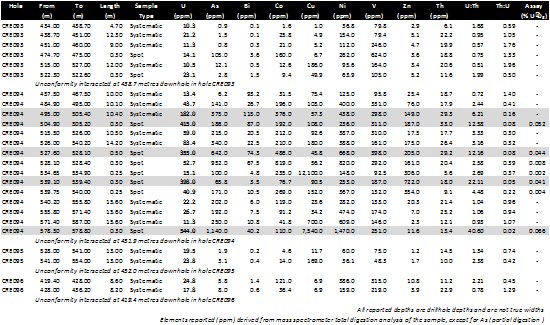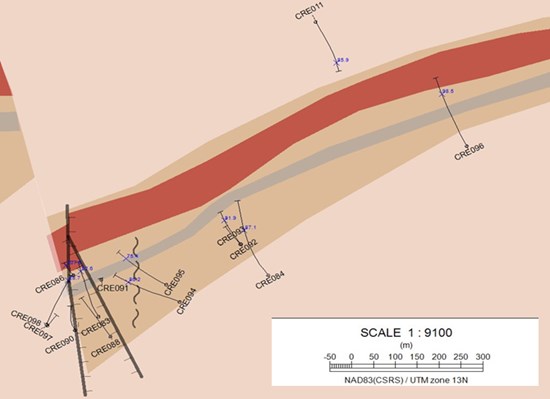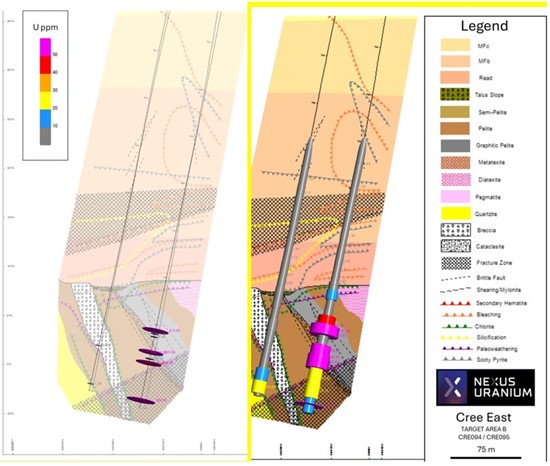Nexus Uranium Intersects Uranium Mineralization at Cree East in Unconformity Test from Winter Drill Program
Nexus Uranium (OTCQB: GIDMF) has reported assay results from its 2025 winter drill program at the Cree East Project in Saskatchewan's Athabasca Basin. The program's key achievement was identifying a 450-metre-long prospective structural corridor within Area B, with one of five unconformity drill tests intersecting uranium mineralization.
Drill hole CRE094 revealed multiple uranium intersections, with the highest grade being 0.066% U₃O₈ over 0.3m. The program also detected elevated levels of pathfinder elements including copper, nickel, cobalt, and thorium, indicating a potentially fertile mineralizing system. All samples were analyzed at the Saskatchewan Research Council Geoanalytical Laboratories following strict QA/QC protocols.
Nexus Uranium (OTCQB: GIDMF) ha comunicato i risultati delle analisi del suo programma di perforazione invernale 2025 presso il Progetto Cree East nella Athabasca Basin della Saskatchewan. Il risultato principale del programma è stato l'identificazione di un corridor strutturale prospettico lungo 450 metri nell'Area B, con uno dei cinque test di perforazione sull'inconformità che ha intercettato mineralizzazione di uranio.
Il foro di sondaggio CRE094 ha mostrato molteplici intersezioni di uranio, con la concentrazione più alta pari a 0,066% U₃O₈ su 0,3 m. Il programma ha inoltre rilevato livelli elevati di elementi indicatori come rame, nichel, cobalto e torio, suggerendo un sistema mineralizzante potenzialmente fertile. Tutti i campioni sono stati analizzati presso i laboratori geoanalitici del Saskatchewan Research Council seguendo rigorosi protocolli QA/QC.
Nexus Uranium (OTCQB: GIDMF) ha reportado los resultados de los análisis de su programa de perforación invernal 2025 en el Proyecto Cree East en la Cuenca de Athabasca, Saskatchewan. El logro principal del programa fue identificar un corredor estructural prospectivo de 450 metros de longitud dentro del Área B, con una de las cinco pruebas de perforación en la inconformidad intersectando mineralización de uranio.
El pozo de perforación CRE094 reveló múltiples intersecciones de uranio, con la ley más alta de 0.066% U₃O₈ sobre 0.3 m. El programa también detectó niveles elevados de elementos indicativos como cobre, níquel, cobalto y torio, lo que indica un sistema mineralizador potencialmente fértil. Todas las muestras fueron analizadas en los laboratorios geoanalíticos del Saskatchewan Research Council siguiendo estrictos protocolos de control de calidad (QA/QC).
Nexus Uranium (OTCQB: GIDMF)는 사스카추완 주 아서배스카 분지에 위치한 Cree East 프로젝트의 2025년 겨울 시추 프로그램 결과를 보고했습니다. 이번 프로그램의 주요 성과는 B 지역 내에서 길이 450미터의 잠재적 구조적 지대를 확인한 것이며, 다섯 번의 부정합 시추 테스트 중 하나에서 우라늄 광물이 발견되었습니다.
시추공 CRE094에서는 여러 차례 우라늄 광물 구간이 확인되었으며, 최고 등급은 0.3m 구간에서 0.066% U₃O₈였습니다. 또한 구리, 니켈, 코발트, 토륨 등 경로 원소의 고농도도 감지되어 잠재적으로 유망한 광물화 시스템임을 시사합니다. 모든 시료는 엄격한 QA/QC 절차에 따라 사스카추완 연구위원회 지구분석 연구소에서 분석되었습니다.
Nexus Uranium (OTCQB : GIDMF) a annoncé les résultats des analyses de son programme de forage hivernal 2025 sur le projet Cree East dans le bassin d'Athabasca en Saskatchewan. La principale réussite du programme a été l'identification d'un couloir structural prospectif de 450 mètres de long dans la zone B, avec l'une des cinq forages d'inconformité interceptant une minéralisation d'uranium.
Le forage CRE094 a révélé plusieurs intersections d'uranium, avec une teneur maximale de 0,066% U₃O₈ sur 0,3 m. Le programme a également détecté des niveaux élevés d'éléments indicateurs tels que le cuivre, le nickel, le cobalt et le thorium, suggérant un système minéralisant potentiellement fertile. Tous les échantillons ont été analysés dans les laboratoires géoanalytiques du Saskatchewan Research Council selon des protocoles rigoureux de QA/QC.
Nexus Uranium (OTCQB: GIDMF) hat die Analyseergebnisse seines Winterbohrprogramms 2025 am Cree East Projekt im Athabasca-Becken von Saskatchewan veröffentlicht. Der wichtigste Erfolg des Programms war die Identifikation eines 450 Meter langen potenziellen Strukturkorridors im Bereich B, wobei eine von fünf Bohrungen an der Diskordanz Uranmineralisierung schnitt.
Das Bohrloch CRE094 zeigte mehrere Uranabschnitte, wobei die höchste Konzentration 0,066% U₃O₈ über 0,3 m betrug. Das Programm entdeckte außerdem erhöhte Gehalte an Spurenelementen wie Kupfer, Nickel, Kobalt und Thorium, was auf ein potenziell ergiebiges mineralisierendes System hinweist. Alle Proben wurden im Geoanalytischen Labor des Saskatchewan Research Council unter strengen QA/QC-Protokollen analysiert.
- None.
- Only one out of five drill tests intersected uranium mineralization
- Relatively low-grade uranium intersections (highest 0.066% U₃O₈)
- True widths of mineralization zones currently unknown
Vancouver, British Columbia--(Newsfile Corp. - July 16, 2025) - Nexus Uranium Corp. (CSE: NEXU) (OTCQB: GIDMF) (FSE: 3H1) ("Nexus" or the "Company") is pleased to report assay results from its 2025 winter drill program at the Cree East Project in the Athabasca Basin, Saskatchewan. The program comprised five unconformity drill tests, one of which intersected uranium mineralization. A key outcome of the program was the delineation of a 450-metre-long prospective structural corridor within Area B.
Highlights from CRE094:
0.066% U₃O₈ over 0.3 m from 578.50 m0.052% U₃O₈ over 0.3 m from 504.90 m0.044% U₃O₈ over 0.3 m from 539.10 m0.041% U₃O₈ over 0.5 m from 527.60 m
The reported intervals are intercept lengths, the true widths are unknown
"The results from our winter drill program continue to validate the potential of the Cree East Project. Intersecting uranium mineralization in one hole and identifying a structural corridor over 450 metres is a significant step forward," commented Jeremy Poirier, CEO of Nexus Uranium. "The presence of pathfinder elements such as copper, nickel, and cobalt alongside uranium strengthens our confidence that we are within a highly prospective mineralized system. These results set the stage for focused follow-up work to target higher-grade zones and advance toward a potential discovery."
2025 Cree East Winter Drill Program
The 2025 Winter Drill Program (the "Program") was designed to build on historical drilling by CanAlaska and its Korean partners (2008-2012), with a specific focus on Area B. The objective was to follow up on previously identified uranium enrichment and enhance the understanding of basement structure (including graphitic conductors and faulting), alteration patterns, and mineralization controls. The Program successfully delineated a graphitic-pelitic conductor unit characterized by structural features indicative of post-Athabasca reactivation, associated hydrothermal alteration, and elevated radioactivity.
In addition to uranium mineralization, the drill program returned elevated concentrations of several other metals, including copper (Cu), lead (Pb), zinc (Zn), nickel (Ni), molybdenum (Mo), cobalt (Co), thorium (Th), and vanadium (V). These elements were spatially associated with the uranium-enriched intervals and are considered significant from a geochemical and exploration standpoint.
Elevated levels of these metals-often referred to as pathfinder elements-are commonly associated with the hydrothermal systems that control uranium deposition in the Athabasca Basin. Their co-occurrence with uranium, particularly within structurally complex and altered zones, is a strong indicator of a fertile mineralizing system. For example:
- Nickel and cobalt are typically found in reductive, graphitic basement rocks where uranium often precipitates.
- Copper and lead may reflect the presence of sulphide-rich hydrothermal fluids capable of transporting uranium.
- Thorium and vanadium are frequently associated with alteration halos peripheral to uranium mineralization.
- Molybdenum is sensitive to changes in redox conditions, its presence can be indicative of conditions under which uranium mineralization is formed
The presence and distribution of these pathfinder elements strengthen the geological model and provide valuable vectoring tools for identifying and targeting potential zones of higher-grade uranium in future exploration campaigns.

Figure 1: Assay Result Highlights
To view an enhanced version of this graphic, please visit:
https://images.newsfilecorp.com/files/7273/258933_d0258ca9d427abff_001full.jpg
The reported lengths are intercept lengths, true widths are unknown
Sampling and Analytical Protocols
Drill core sampling for the 2025 Winter Program followed CanAlaska's established protocol, which classifies samples as either systematic or spot based on geological context and analytical needs.
- Systematic samples are composite in nature and are used to characterize broader geological intervals. These consist of 1-2 cm disks of whole core collected at the start of each row of core in the core box over 9 to 20 metre intervals. The collected core fragments are composited into a single sample for pathfinder element analysis.
- Spot samples are targeted and collected from discrete geological features requiring higher-resolution geochemical analysis. These comprise 0.25-0.5 metre continuous half-core splits taken from mineralized intervals or zones of interest.
All core samples were securely transported to the Saskatchewan Research Council (SRC) Geoanalytical Laboratories in Saskatoon for preparation and analysis. The SRC, an ISO/IEC 17025/2005 and Standards Council of Canada accredited facility, conducted multi-element geochemical analysis using:
- ICP-MS and ICP-OES (total digestion: HF:HNO₃:HClO₄; partial digestion: HNO₃:HCl),
- Boron by fusion, and
- U₃O₈ wt% by ICP-OES using higher-grade reference standards.
Sample intervals were selected based on geological logging, scintillometer (CT007-M) readings, and downhole probe results. One half of each split spot sample was retained for reference, with the other sent for analysis. Quality control measures included routine insertion of blanks, standards, and duplicates both by field crews and SRC, in line with best practices for QA/QC. All assay data are subject to independent verification by qualified persons prior to disclosure.
The Company notes that total gamma measurements are derived from CT007-M handheld scintillometer readings and reported in counts per second (cps). These measurements are preliminary and indicate the presence of radioactive elements such as uranium, thorium, and/or potassium, but do not directly quantify uranium content. Values above 100 cps are considered elevated; however, only laboratory assays can confirm uranium concentrations.

Figure 2: Plan View of Drilling in Area B
To view an enhanced version of this graphic, please visit:
https://images.newsfilecorp.com/files/7273/258933_d0258ca9d427abff_002full.jpg

Figure 3: Cross Section of CRE094 and CRE095 samples: spot (left) and systematic (right)
To view an enhanced version of this graphic, please visit:
https://images.newsfilecorp.com/files/7273/258933_nexus%20figure%203.jpg
About Nexus Uranium Corp.
Nexus Uranium Corp. is a multi-commodity development company focused on advancing the Cree East uranium project in the Athabasca Basin in addition to its precious metals portfolio that includes the Napoleon gold project in British Columbia and a package of gold claims in the Yukon. The Cree East project is one of the largest projects within the Athabasca Basin of Saskatchewan spanning 57,752 hectares (142,708 acres) and has seen over
The technical content of this news release has been reviewed and approved by Warren D. Robb, P.Geo. (BC), a Director and VP Exploration of Nexus Uranium Corp. and a Qualified Person under National Instrument 43-101.
—
FOR FURTHER INFORMATION, PLEASE CONTACT:
Jeremy Poirier
Chief Executive Officer
info@nexusuranium.com
This news release contains "forward-looking information" and "forward-looking statements" within the meaning of applicable Canadian securities laws. Forward-looking information is generally identifiable by the use of forward-looking terminology such as "anticipates," "believes," "plans," "expects," "intends," "estimates," "may," "could," "should," "would," or similar expressions, and includes statements regarding the potential of the Cree East Project, anticipated follow-up work, future exploration plans, and the expected geological interpretations of assay results.
Such statements are based on assumptions and factors considered reasonable as of the date they are made, including management's current expectations, exploration plans, geological interpretations, and market conditions. Forward-looking statements involve known and unknown risks, uncertainties, and other factors that may cause actual results, performance, or achievements to differ materially from those expressed or implied. These risks include, but are not limited to: delays in obtaining necessary permits, changes in exploration or project plans, availability of capital and financing, regulatory developments, adverse weather or logistical challenges, and risks inherent to the mineral exploration industry.
Although Nexus Uranium has attempted to identify important factors that could cause actual results to differ materially from those contained in forward-looking statements, there may be other factors that cause outcomes not to be as anticipated, estimated, or intended. Readers are cautioned not to place undue reliance on forward-looking information, which is provided as of the date hereof, and the Company does not undertake any obligation to update or revise any forward-looking statements, whether as a result of new information, future events, or otherwise, except as required by applicable law.
All scientific and technical information contained in this release has been reviewed and approved by Warren D. Robb, P.Geo. (BC), a Director and VP Exploration of Nexus Uranium Corp., who is a Qualified Person as defined by National Instrument 43-101 - Standards of Disclosure for Mineral Projects.
To view the source version of this press release, please visit https://www.newsfilecorp.com/release/258933







